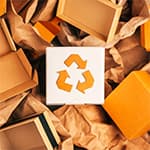
Packaging reporting
If your company is an obligated packaging producer, by law you need to be affiliated to an approved producer responsibility organisation and through it report the packaging volumes you put on the Swedish market. As an affiliated producer to Näringslivets Producentansvar, we help you with your packaging reporting and submit your report to the Swedish Environmental Protection Agency.
In this guide, we will go through what, how, and when you should report your packaging.
Packaging reporting guide
Frequently asked questions
If you manufacture or import packaging that is not service packaging, these must be reported by the filler (your customers). You only report the packaging you fill yourself and the packaging in which your imported goods are shipped.
Read more about service packaging in chapter 2.2. of Näringslivets Producentansvar’s Instructions.
No. In order to avoid that all stores, catering services, restaurants, pizzerias, hot dog stands, pastry shops, laundries, growers, berry pickers, egg producers and more should become affiliated to us because they provide a point-of-sale packaging, special conditions are applied, in accordance with current legislation. These packages are filled at the time of sale and are called service packaging. Common for them is that they are reported by the packaging manufacturer or importer. For other packaging, it is always the filler that has the producer responsibility and must report the packaging.
Producer responsibility is a statutory obligation. Producer responsibility is based on the Polluter Pays Principle (PPP). If your company introduces packaging to the Swedish market, you, as the producer, have a legal and financial responsibility for the collection and recycling of the packaging. Producer responsibility is the foundation of the collection and recycling system for packaging in Sweden.
The basic idea behind producer responsibility is to reduce the amount of waste, but also to ensure that any waste that is generated is recycled and used to make new products.
In the ordinace on producer responsibility for packaging, Chapter 8, Section 2, the following definition serves as the basis for reporting packaging for private use:
“In this chapter, packaging intended for private use refers to packaging normally used by private individuals or intended for use by both private individuals and businesses.”
An example of packaging considered intended for private use is a one-liter milk carton. Whether the milk carton is purchased and used by employees at a company or used by private individuals, it is considered packaging intended for private use. However, a larger milk carton (e.g., 10 liters) is not considered packaging intended for private use. This is because it is assumed to be intended for use by a business (e.g., in large kitchens or other restaurant operations) and not by private individuals.
Related information and instructions
fileRoundbool: false
filesInvertbool: false






